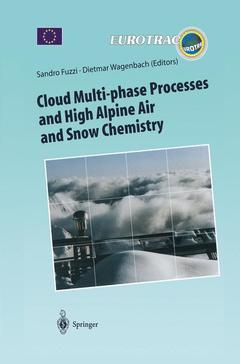Cloud Multi-phase Processes and High Alpine Air and Snow Chemistry, 1997 Ground-based Cloud Experiments and Pollutant Deposition in the High Alps Transport and Chemical Transformation of Pollutants in the Troposphere Series, Vol. 5
Langue : Anglais

Among the chemical and physical processes involved in the transformation of pollutants between their sources and their ultimate deposition, those associated with clouds, aerosols and precipitation must be rated as the most difficult both to study and to understand. This book presents a variety of recent advances in this field, including the properties and composition of aerosol particles, chemical transformation and scavenging processes, the relationship between liquid-phase chemistry and cloud micro-physics, entrainment, evaporation and deposition, trends in high Alpine pollution, transport processes, and developments in instrumentation. This book is Volume 5 in the ten-volume series on Transport and Chemical Transformation of Pollutants in the Troposphere.
I Ground-Based Cloud Experiments (GCE).- 1 GCE: an Overview.- 1.1 Introduction.- 1.2 Overview of the Three GCE Joint Field Experiments.- 2 Principal Results from GCE.- 2.1 Size Distribution, Hygroscopic Properties and Chemical Composition of Aerosol Particles.- 2.2 Nucleation Scavenging.- 2.3 Other in-Cloud Particle Scavenging Processes.- 2.4 Scavenging of Gases.- 2.5 Cloud Droplet Liquid-Phase Chemistry and its Dependence on Cloud Microphysics.- 2.6 Effect of Entrainment on Cloud Chemistry and Microphysics.- 2.7 Evaporating Clouds.- 2.8 Cloud Droplet Deposition.- 2.9 Instrument Development and Testing within GCE.- 3 GCE in Retrospective.- 3.1 Meeting the Original Goals of GCE.- 3.2 The Importance of Integrated Field Work, Instrumental Development and Modelling.- 3.3 Airborne Measurements as a Complement to Ground-Based Investigations.- 3.4 Joint Evaluation and Dissemination of GCE Results.- 4 Future Directions for Cloud Research.- 4.1 Effect of Anthropogenic Activity on Aerosol Population.- 4.2 Haze.- 4.3 The Ice Phase of Clouds.- 4.4 Oxidised Nitrogen Chemistry.- 4.5 Organic Chemistry within Clouds.- 4.6 Clouds and Oxidising Capacity of the Atmosphere.- 4.7 Radiative Properties of Clouds.- 4.8 Instrumentation Needs for the Future.- 4.9 Need for Aircraft Measurements.- 5 Individual Reports from GCE Principal Investigators.- 5.1 Field and Wind Tunnel Experiments in Clouds and Fog by ECN.- 5.2 Study of Interstitial Aerosol.- 5.3 Formation and Reactivity of Aerosols.- 5.4 Field and Modelling Studies of Cloud Chemical Processes.- 5.5 The Multiphase Chemistry of Clouds and Fog.- 5.6 A Single Particle Approach to Characterising Droplet Residues and Interstitial Particles.- 5.7 Partitioning of Aerosol Particles Between Droplets and Interstitial Air.- 5.8 Influence of the Chemical Composition of the Atmospheric Particles on Fog and Cloud Formation.- 5.9 The Dynamic Behaviour of Pollutants in Fog and Captive Clouds.- 5.10 The Role of Nitrophenols in Cloud Chemistry.- 5.11 A Droplet Aerosol Analysing System for Cloud Studies.- 5.12 Study of the Interaction of Photo-oxidants and Acidic Components between Gas and Liquid Phase.- 5.13 Input of Trace Substances to High Elevation Forests by Cloud Water Interception.- 6 GCE Publications 1990–1996.- II High Alpine Air and Snow Chemistry.- 7 An Overview of ALPTRAC Research.- 7.1 Introduction.- 7.2 Some Observations and Trends in High Alpine Pollution.- 8 Aims and Internal Structure of ALPTRAC.- 9 Principal Scientific Results.- 9.1 Pollution Levels in High Alpine areas.- 9.2 Seasonal Changes in Pollution Levels.- 9.3 Mechanisms: Chemical Transformation and Scavenging.- 9.4 Transport Processes and Source Areas.- 9.5 Long-Term Trends.- 9.6 Instrumentation Developments.- 9.7 Conclusions.- Individual Reports from ALPTRAC Principal Investigators.- 10 High Alpine Snow Pack Chemistry.- 10.1 Accumulation of Pollutants and Nutrients in the Snow Pack at High Altitudes along a North-South Transect in the Eastern Alps.- 10.2 Stable Isotope Ratio of Sulfur, Nitrogen and Carbon as Pollution Tracers for Atmospheric Constituents.- 10.3 Accumulation of Acidic Components in Two Snowfields in the Sonnblick Region.- 11 Long-Term Pollution Trends.- 11.1 Retrospective and Present State of Anthropogenic Aerosol Deposition at a High Altitude Alpine Glacier (Colle Gnifetti, 4450 m a.s.l.).- 12 High Alpine Air, Aerosol and Cloud Chemistry.- 12.1 Segregation of Hydrometeors.- 12.2 Transport, Scavenging and Deposition Studies of Air Pollutants at High-Alpine Sites.- 12.3 Alpine Aerosol and Snow Chemistry Study at the Sonnblick Observatory (Austria, 3106 m a.s.1.).- 12.4 Aerosol and Hydrometeor Concentrations and their Chemical Composition during Winter Precipitation along a Mountain Slope (Mt. Rigi, Switzerland).- 13 Meteorological Support to ALPTRAC.- 13.1 Meteorological Support Study.- 14 ALPTRAC Publications 1988-1996.- Suject Index.
Among the chemical and physical processes involved in the transformation of pollutants between their sources and their ultimate deposition, those associated with clouds, aerosols and precipitation must be rated as the most difficult both to study and to understand. This book presents a variety of recent advances in this field, including the properties and composition of aerosol particles, chemical transformation and scavenging processes, the relationship between liquid-phase chemistry and cloud microphysics, entrainment, evaporation and deposition, trends in high Alpine pollution, transport processes, and developments in instrumentation.
Date de parution : 10-2012
Ouvrage de 287 p.
15.5x23.5 cm
Disponible chez l'éditeur (délai d'approvisionnement : 15 jours).
Prix indicatif 158,24 €
Ajouter au panierThème de Cloud Multi-phase Processes and High Alpine Air and Snow... :
© 2024 LAVOISIER S.A.S.



